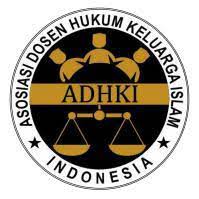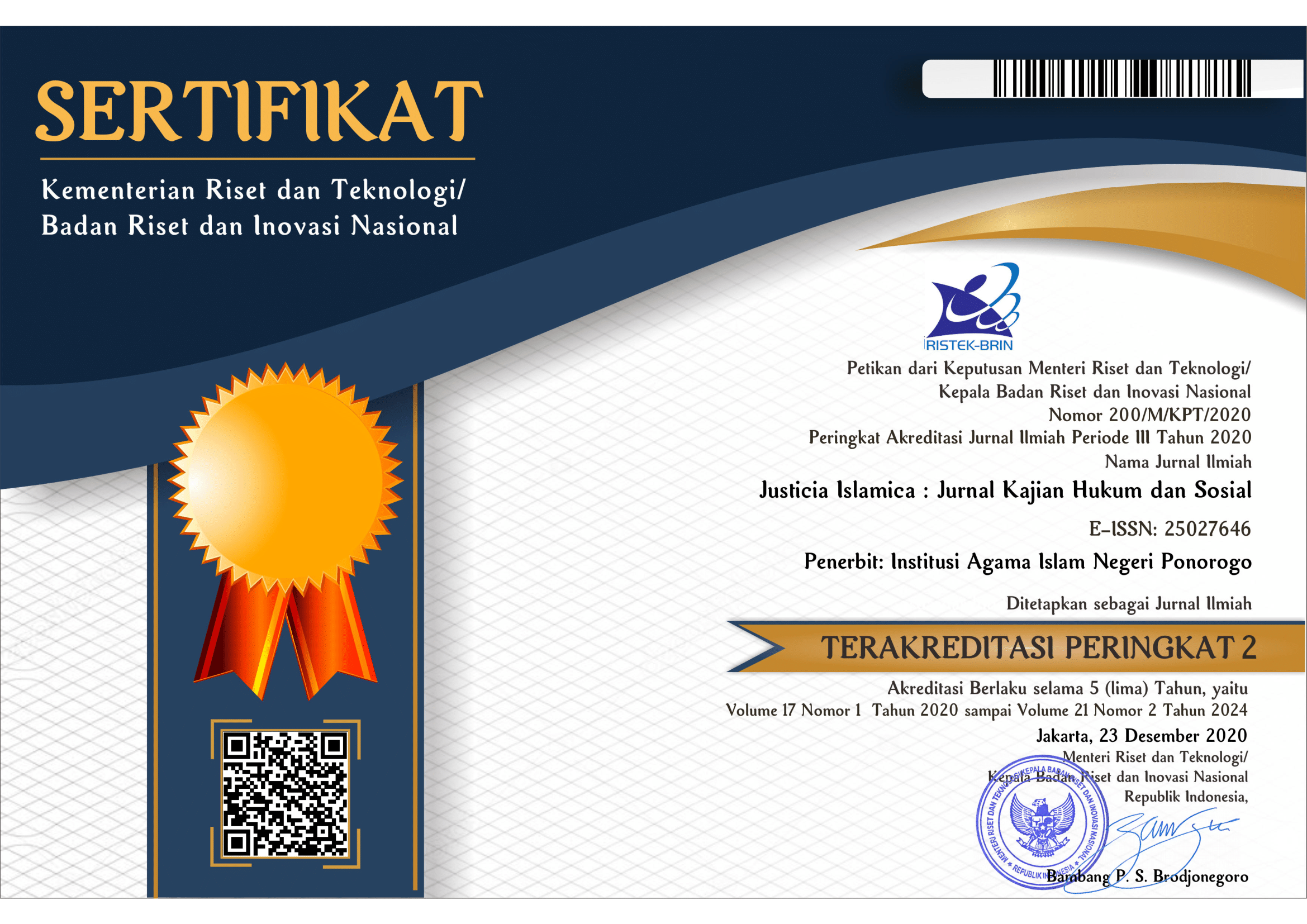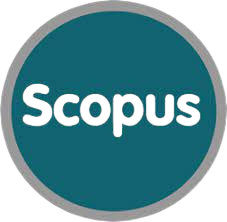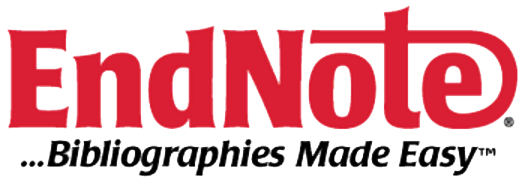The Transformation of DSN-MUI Fatwa in The Unit-Linked Products
A Contemporary Analysis
DOI:
https://doi.org/10.21154/justicia.v17i2.1960Keywords:
Transformation, Fatwa, DSN-MUI, Sharia Insurance, Unit LinkAbstract
This article aims to review more concretely how the fatwa position of DSN-MUI toward Sharia Insurance in Indonesia's legal system and how this fatwa is transformed by insurance companies in the form of Unit Link products. Researchers used library research methods, comparative and correlative approaches, and content analysis techniques to answer this. Based on the analysis, the position of the fatwa of DSN-MUI toward Sharia Insurance is hierarchically equivalent to the position of the laws and regulations based on the provisions stated in Article 1 paragraph 3 of Law No. 40 of 2014 on Insurance. Furthermore, from the aspect of transformation, it is found that there are three patterns of transformation used by insurance companies; there are patterns of adoption, expansion, and narrowing. The narrowing pattern is widely used because of the technical nature of the Unit Link. However, from the aspect of conformity with the fatwa, after the transformation process is carried out, especially in the fatwa of the DSN-MUI regarding wakalah bil ujrah by expanding the meaning of ujrah, it is resulted in deviations from sharia principles, especially considering the types of ujrah as stated in a limited manner in the fatwa. wakalah bil ujrah. This research contributes to providing a way to resolve the implementation of Unit Link.
References
Journal
Hardyanti, Nanda Siti. “Otentisitas Penerapan Asuransi Syariah Di Indonesia.” TAQNIN: Jurnal Syariah Dan Hukum 1, no. 1 (June 26, 2019). https://doi.org/10.30821/taqnin.v1i1.4870.
Ja’far Baehaqi. “Paradoks Fatwa Dewan Syari’ah Nasional Majelis Ulama Indonesia Dalam Regulasi Hukum Perbankan Syari’ah Dan Alternatif Solusinya.” Al-Akhkam 27, no. 1 (2017).
Jamaa, La. “Fatwas of the Indonesian Council of Ulama and Its Contributions to the Development of Contemporary Islamic Law in Indonesia.” Indonesian Journal of Islam and Muslim Societies 8, no. 1 (2018): 29”“56. https://doi.org/10.18326/ijims.v8i1.29-56.
Kholis, Nur. “Islamic Unit Linked: Is It Profitable and Fully Sharia Compliance?” Madania: Jurnal Kajian Keislaman 20, no. 1 (July 1, 2016): 1”“12. https://doi.org/10.29300/madania.v20i1.81.
Masjono, Ali. “Hubungan Maisir , Gharar Dan Riba Dengan Strategi Pembiayaan Berbasis Syariah Di Bank Muamalat Indonesia.” Politeknik Negeri Jakarta, 2016, 351”“59.
Misbach, Irwan. “Kedudukan dan Fungsi Dewan Pengawas Syariah Dalam Mengawasi Transaksi Lembaga Keuangan Syariah di Indonesia.” Jurnal Minds: Manajemen Ide dan Inspirasi 2, no. 1 (March 16, 2015): 79”“93. https://doi.org/10.24252/minds.v2i1.4634.
Mokoginta, Mohamad Fikri. “Penerapan Prinsip Syariah Dalam Perasuransian Menurut Undang-Undang No. 40 Tahun 2014.” LEX PRIVATUM 5, no. 1 (February 17, 2017). https://ejournal.unsrat.ac.id/index.php/lexprivatum/article/view/15108.
Najikha Akhyati, and Muhammad Maksum. “Transformasi Fatwa Dsn-Mui Tentang Akad Musyârakah Mutanâqisah Dalam Peraturan Perundang-Undangan.” SYAR’IE 3, no. 2 (2020).
Nur Kholis. “Islamic Unit Linked: Is It Profitable and Fully Sharia Compliance?” MADANIA 20, no. 1 (2016).
Rofi’ah, Khusniati. “Membincang Praktik Asuransi Di Indonesia: Telaah Sosiologi Hukum.” Justicia Islamica 10, no. 1 (2013): 135”“58. https://doi.org/10.21154/justicia.v10i1.145.
Siregar, Saparuddin, Nur Kholis, and M. Yasir Nasution. “Measuring the Benefit of Islamic Unit Linked for Customer by ANP (Analytic Network Process).” Journal of Islamic Economics Lariba 4, no. 2 (January 10, 2019): 57”“70.
Tuti Hasanah. “Transformasi Fatwa Dewan Syariah Nasional Ke Dalam Hukum Positif.” SYARIAH Jurnal Hukum Dan Pemikiran 16, no. 2 (2016): 161”“71.
Umam, Khotibul. “Legislasi Fikih Ekonomi Perbankan: Sinkronisasi Peran Dewan Syariah Nasional Dan Komite Perbankan Syariah.” Mimbar Hukum - Fakultas Hukum Universitas Gadjah Mada 24, no. 2 (2012): 357”“75. https://doi.org/10.22146/jmh.16139.
Wahab, Abdul Rahim Abdul, Mervyn K. Lewis, and M. Kabir Hassan. “Islamic Takaful: Business Models,Shariah Concerns, and Proposed Solutions.” Thunderbird International Business Review 49, no. 3 (May 2007): 371”“96. https://doi.org/10.1002/tie.20148.
Wahid, Soleh Hasan. “Pola Transformasi Fatwa Ekonomi Syariah DSN-MUI Dalam Peraturan Perundang-Undangan Di Indonesia.” Ahkam: Jurnal Hukum Islam 4, no. 2 (November 1, 2016): 171”“98. https://doi.org/10.21274/ahkam.2016.4.2.171-198.
Book
Ahyar A. Gayo. Hukum Tentang Kedudukan Fatwa Mui Dalam Upaya Mendorong Pelaksanaan Ekonomi Syariah. Jakarta: Puslitbang BPHN, 2011.
Barber, Brad M., and Terrance Odean. “Handbook of the Economic of Finance. Chapter 22 the Behavior of Individual Investors.” Elsevier, 2013, 1547”“50.
Nafis, M. Cholil. Teori Hukum Ekonomi Syariah. Jakarta: UI Press, 2011.
Website
Kemdikbud. “Kamus Besar Bahasa Indonesia (KBBI),” n.d. https://kbbi.web.id/transformasi. accessed November 6, 2020.
Fatwa, Publication
DSN MUI. “Fatwa Asuransi Syariah.” Jakarta: MUI Indonesia, 2020.
Keuangan, Otoritas Jasa. Road Map IKNB Syariah 2015-2019. Jakarta: OJK, 2015.
Downloads
Published
Issue
Section
License
Copyright (c) 2020 Atik Abidah

This work is licensed under a Creative Commons Attribution-ShareAlike 4.0 International License.
Requirements to be met by the author as follows:
- Author storing copyright and grant the journal right of first publication manuscripts simultaneously with licensed under the CC BY-SA allows others to share the work with a statement of the work's authorship and initial publication in this journal.
Authors can enter into the preparation of additional contractual separately for the non-exclusive distribution of a decadent version of the journal issue (e.g., post it to an institutional repository or publish it in a book), with the recognition of initial publication in this journal.
Authors are allowed and encouraged to post their work online (e.g., in institutional repositories or on their website) before and during the submission process because it can lead to productive exchanges and citations earlier and more severe than published works. (see The Effect of Open Access).
This work is licensed under CC BY-SA.


















